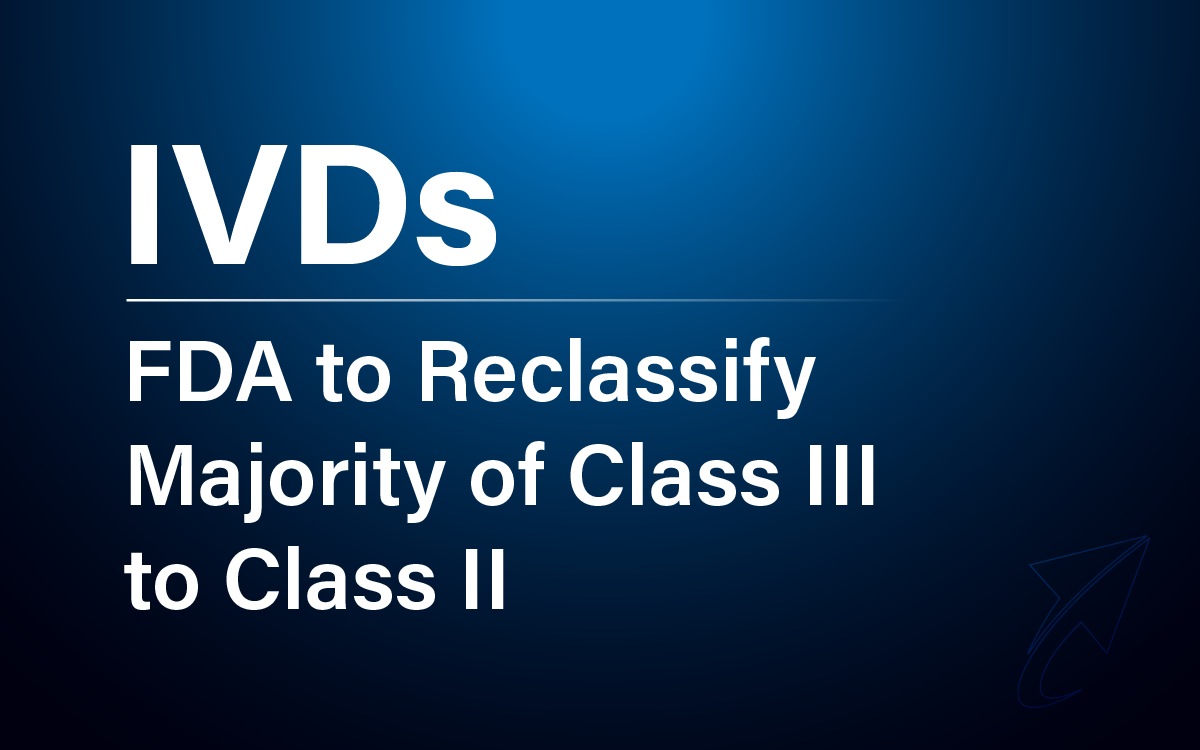The FDA's Reclassification of IVDs and Implications for LDTs
In the rapidly evolving world of in vitro Diagnostic (IVD) devices, staying abreast of regulatory changes is crucial. We’re committed to keeping you informed about these developments so be sure to subscribe for our IVDwise updates or check back often. A recent announcement by the FDA marks a significant shift in the regulatory landscape for IVDs, particularly those in high-risk categories.
The FDA’s Announcement on IVD Reclassification
On January 31, 2024, the FDA declared its intent to reclassify the majority of Class III (high-risk) IVDs to Class II (moderate-risk), primarily affecting infectious disease and companion diagnostic IVDs. Jeff Shuren, M.D., J.D., Director of the FDA’s Center for Devices and Radiological Health (CDRH), emphasized that this reclassification aims to simplify the marketing clearance process, shifting from the stringent premarket approval (PMA) pathway to the less burdensome premarket notification (510(k)) pathway.
Dr. Shuren noted, “Such reclassifications may support the potential for more manufacturers to develop these tests, which can increase competition and increase access to these important tests.” This reflects the FDA’s commitment to fostering innovation and accessibility in the healthcare sector.

At a glance —
On January 31, 2024, the FDA declared its intent to reclassify the majority of Class III IVDs to Class II.
Reclassification has been an ongoing process at the FDA. For example, certain HCV tests were reclassified to Class II in 2021 with more tests discussed in late 2023.
The FDA plans to continue its risk-based approach for IVD classifications.
This broader reclassification effort follows newly proposed regulations for Laboratory Developed Tests (LDTs).
Specific Reclassifications Underway
This has been an ongoing process at FDA, in December of 2021, HCV was reclassified to Class II for (1) nucleic acid-based HCV ribonucleic acid devices intended for the qualitative or quantitative detection or genotyping of HCV RNA, and (2) certain HCV antibody devices intended for the qualitative detection of HCV antibodies. It’s important to note that tests intended for blood streaming were not reclassified and remain Class III due to the potential risk of infection. In a September 2023 panel meeting, discussions were held regarding reclassifying three types of infectious disease diagnostic tests from Class III to Class II with special controls:
- Nucleic acid and serology-based IVDs for Hepatitis B Virus (HBV).
- Serology-based IVDs for human parvovirus B19.
- Cell-mediated immune reactivity IVDs for Mycobacterium tuberculosis.
Continued Risk-Based Approach and Future Reclassifications
The FDA remains dedicated to a risk-based approach for initial IVD classifications. Dr. Shuren elaborated, “Based on our experience, we believe that special controls could be developed, along with general controls, that could provide a reasonable assurance of safety and effectiveness for most future companion diagnostic and infectious disease IVDs.” This approach could lead to more devices being regulated as Class II.
Changes in Laboratory Developed Tests (LDTs)
Significant changes are also underway for Laboratory Developed Tests (LDTs). Historically, the FDA exercised enforcement discretion over LDTs, exempting them from certain premarket submissions. In September 2023, the FDA proposed standardizing premarket requirements for LDTs. Read about the FDA’s Proposed Regulations for Laboratory Developed Tests for a detailed understanding of the changes and potential implications.
Implications for LDTs
While this reclassification effort aligns with the FDA’s ongoing campaign to ensure that devices are regulated appropriately, this shift offers new strategic considerations in product development and regulatory compliance for IVD manufacturers.
Alignment with IVD Regulations and CMS
With LDTs expected to fall under similar regulatory frameworks as other IVDs, laboratories will need to prepare for more rigorous compliance requirements. Notably, the FDA and CMS jointly rejected the notion of expanding CLIA to oversee LDTs.
Impact on Development and Innovation
This shift may influence how new LDTs are developed, potentially requiring more resources for compliance but also opening avenues for broader use and recognition.
Enhanced Patient Safety and Quality Assurance
More stringent FDA oversight of LDTs could lead to improved safety and reliability of these tests, ultimately benefiting patient care.
We’re here to help
As the landscape evolves, MDC Associates is here to help adapt regulatory strategies to make the most of these changes and choose the most sensible path to market for new diagnostic tests.

